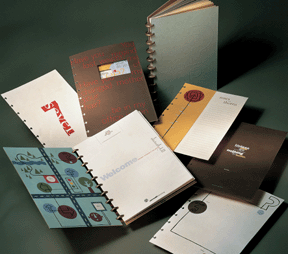Pure Print
The designers who still think touchy feely is much better than webby designy.
By: Carol Carter
It’s an elite group. Graphic designers who don’t design websites. Call them purists if you must, but also call them busy and focused. And in the case of Vanessa Lowry of Lowry Vickers Design, call her done.
“I really like for projects to have a start and an end,” Lowry says. “It’s exciting to design a project, and I like that part. The revision part is really not fun for me, but I know it’s a necessary part of every project. I like to see a project go through a whole cycle. It starts, cycles through and finishes. That finish is exciting for me. And, web pages never really finish. They just go on forever.
“When I was making the decision about whether to buy the software and take the classes to learn web design, that was one of the factors that made me think it was not my cup of tea, that it was kind of an unending thing. I like things that end,” says Lowry, who adds that she also likes to know how her finished pieces will look to the people who see them, something she thinks is not entirely possible with online work.
“There are so many unknown factors to web design. When you have a print piece, you design it, and it looks like that when it’s finished. If you design something for the web, the way it looks depends on the browser that people are using to view it. It depends what the settings are on their machine, what their preference fonts are. You really don’t have a lot of control over what the end page looks like to the person who is viewing it,” she says.
 Work by Lowry Vickers.
Work by Lowry Vickers.
That Pesky Thing We Call The Web
Even though Lowry eschews web design, it still manages to affect her work. “It has created some challenges from the standpoint that everything that’s on the web is such a low resolution. If a client comes to me and says, ‘I want to duplicate what’s on my website in my print materials,’ it’s a lot harder than if they’re coming from print - if they say they want to design this print campaign and then transfer it over to their website. It’s easier to build it at a higher resolution and then go down for a website than it is to duplicate exactly what they’ve got on the website in a higher resolution for print.”
That’s been the biggest challenge the web has created for Lowry - making clients understand that if they pull words and images from the web they may get reduced quality.
“I’ve had instances where the resolution isn’t as good as I would ideally like for it to be, and I just try to make clients very aware of that before it goes to print. I say, ‘This is potentially going to be a problem. We can pay extra for some proofing stages,’ which we have done on occasion just so the client knows exactly what the logo or the graphic that they’ve pulled off the web is going to look like when it’s printed,” she explains.
“Sage” Advice
Vicki Strull founded her graphic design firm, Sage, five years ago. Like Vanessa Lowry, Strull made a conscious decision not to do web design.
“When web design first became prevalent, the people who were requesting it wanted only something that grabbed attention, so if it spun on the screen or it flashed across the screen, that’s what they thought was a good website. That wasn’t good design, and I was only interested in doing good design,” Strull remembers.
Fortunately, she says, a year or two later web design began to improve. That’s when Strull recalls that some of the design magazines started talking about web design. “At that point, there were some really high - end firms that were doing it. ‘Salon’ magazine has a good site. And MOMA (the Metropolitan Museum of Art) has a good site. Then, all of a sudden, some of the catalogs came out with well-designed sites - because the designs were based on the look of the catalogs, which used top design to begin with. These catalog site designs-such as J. Crew and Pottery Barn - weren’t based out of zero. There was a basis for it.”
 Work by Sage.
Work by Sage.
One technical aspect of print design that Strull prefers over web design is sequencing. “When I design something,” she clarifies, “I follow a sequence. The difference to me, in web design and, say, print design on a brochure, is that you lose control over page sequence on the web. In a brochure, a reader can be in the body on page 4, and I know that they’ve seen page 2 first. On a web, the user can click to any page that I’ve designed. So, I have to design in a way that I know that each page read might precede a page in a way that I don’t intend. It’s not intimidating; it’s just something to keep in mind when designing. You have to have some basic elements on all web pages - not as many as on the home page, but a designer has to structure the pages in a way that users don’t feel lost.”
Playing On Their Strengths
Strull and Lowry - along with Sarah Alvarez of Design Seven and Marcia Romanuck, Owner of The Design Company - feel that they’re playing to their strengths by sticking to print and leaving web design up to experts in that field.
“I don’t want to have anything to do with the part of the business that I know nothing about,” Alvarez points out. “What we are finding is that folks don’t mind so much if they have to go elsewhere for web design. What they do want to be assured of is that the graphics they pay us for, and the look and feel that we come up with can be carried through onto their website.”
To do web right, Alvarez adds, a designer has to be able to make the page smart - in the sense of how it flows from link to link - as well as making it pretty. “You’ve got to have a computer guy, and you’ve got to have a design guy, and if you can’t have both together, why even bother?”
Lowry, too, says it made more sense to her to stay with her strengths and continue building on those strengths rather than trying a whole new direction, especially since there already were people who had been doing web design for awhile.
Romanuck’s firm took on one client where the job was designing a website. “We did some initial design work, and while we did the layout and the design focus, when it came to actually producing it, I had learned enough to know that it was pretty overwhelming. We weren’t going to be able to do it in the time frame that the client wanted and as economically as people who already knew how to do web design.”
So, she sticks to print. “I think it’s like other areas where you might see a client who says, ‘We did our own logo or stationary in house,’ and it really reflects that. It’s the same thing with the web. I don’t want to do somebody’s website and feel that we’re not doing the best job that can be done.”
Pick a Partner
Strull, who enlists a web designer when the job calls for it, echoes Romanuck’s view. “It would do my clients an injustice if I didn’t partner with somebody who is more experienced in web design. Just as I have experience in designing for print, let’s say a client went to a web designer and said, ‘Hey, can you do my letterhead?’ The client might end up with a finished product with foil stamps and die cuts by going to someone with no print experience.”
Nowadays, Strull says, whether a professional is designing a website or a print piece, the concept phase probably is not all that different. But she doubts that was always the case.
“Now there are some good web designers out there, though initially the web designers may have had the technical expertise but not the design expertise. I had design expertise, and I didn’t want to become a programmer. My value to the client is in the design and the concept. In the beginning, there weren’t that many people I could find who specialized in web design. Now, if a client asks me to do a website, I have someone I partner with. I’ll set up the look, and they’ll set up the website. They are, at this point, better at web design simply because they done it, and I haven’t.”
Similar to Strull, Romanuck sometimes brings in an outside contractor for web work. In other cases, she may recommend an outside firm and have the client deal with them directly. “We’ve done that in a couple of cases where we say to the client, ‘You work with this firm, but we’ll oversee the design and make sure the web works with our design.’ ”
Lowry observes another aspect of web design. “It’s kind of like where desktop publishing was back in the 1980s, where everybody with a computer thought they were experts at desktop publishing. It took awhile for those people to realize that if they wanted a professional look they had to hire a professional. I think web design is in that spot right now. There are a lot of people who thought, ‘I can do this myself. Why should I hire somebody to do it?’ They don’t always see the benefit of what a good designer can bring to the table.”
Hooked on the Web
Even though Lowry doesn’t design websites, she’s hooked on the web for other rea-
sons. “I use the web all the time. It’s been very positive for me. It’s a great research tool, and it’s a great way to find stock photography and the kinds of thing that, before, would have taken hours and hours and hours of going through books and talking with reps.”
All of these designers have plenty of work without adding web design. Strull’s principal clients are a floor covering manufacturer and a satellite communications firm. She designs everything from brochures to sample folders for carpet swatches to boxes and point of purchase materials.
Lowry’s biggest clients are a law firm and a homebuilder along with a martial arts business and a nonprofit organization. She creates brochures, newsletters, logos, ads and direct mail pieces.
Alvarez, Director of Client Services for Design Seven, says the firm “specializes in anything that prints - logos, corporate identity, brochures, any sort of collateral.” Design Seven is owned by Debbie McKinney. Romanuck’s specialty is packaging, and her clients represent industries from food to vitamins to wine.
Romanuck’s view on sticking to her specialty seems to reflect the thoughts of all these designers: “Today, with the economy like it is, it’s best to stay small and lean and do what you do best.”
For Romanuck, Alvarez, Lowry, and Strull that is pure print design in the age of integration.
 Work by Lowry Vickers.
Work by Lowry Vickers. Work by Lowry Vickers.
Work by Lowry Vickers. Work by Sage.
Work by Sage.